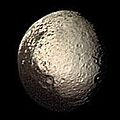Файл:Iapetus by Voyager 2 - enhanced.jpg
Зовнішній вигляд
Iapetus_by_Voyager_2_-_enhanced.jpg (350 × 350 пікселів, розмір файлу: 19 КБ, MIME-тип: image/jpeg)
Історія файлу
Клацніть на дату/час, щоб переглянути, як тоді виглядав файл.
| Дата/час | Мініатюра | Розмір об'єкта | Користувач | Коментар | |
|---|---|---|---|---|---|
| поточний | 17:29, 4 квітня 2005 |  | 350 × 350 (19 КБ) | Smartech~commonswiki | *'''Iapetus by Voyager 2 spacecraft, August 22, 1981''' *same as Iapetus_by_Voyager_2.jpg but focused on the mooon and feature-enhanced. *original image caption: Saturn's outermost large moon, Iapetus, has a bright, heavily cratered icy terrain and a da |
Використання файлу
Такі сторінки використовують цей файл:
Глобальне використання файлу
Цей файл використовують такі інші вікі:
- Використання в ar.wikipedia.org
- Використання в be-tarask.wikipedia.org
- Використання в be.wikipedia.org
- Використання в ca.wikipedia.org
- Використання в de.wikipedia.org
- Використання в el.wikipedia.org
- Використання в en.wikipedia.org
- Використання в eo.wikipedia.org
- Використання в es.wikipedia.org
- Використання в eu.wikipedia.org
- Використання в fr.wikipedia.org
- Використання в gl.wikipedia.org
- Використання в hr.wikipedia.org
- Використання в it.wikipedia.org
- Використання в ja.wikipedia.org
- Використання в ko.wikipedia.org
- Використання в la.wikipedia.org
- Використання в lb.wikipedia.org
- Використання в lt.wikipedia.org
- Використання в lv.wikipedia.org
- Використання в ms.wikipedia.org
- Використання в mwl.wikipedia.org
- Використання в no.wikipedia.org
- Використання в pl.wikipedia.org
Переглянути сторінку глобального використання цього файлу.




